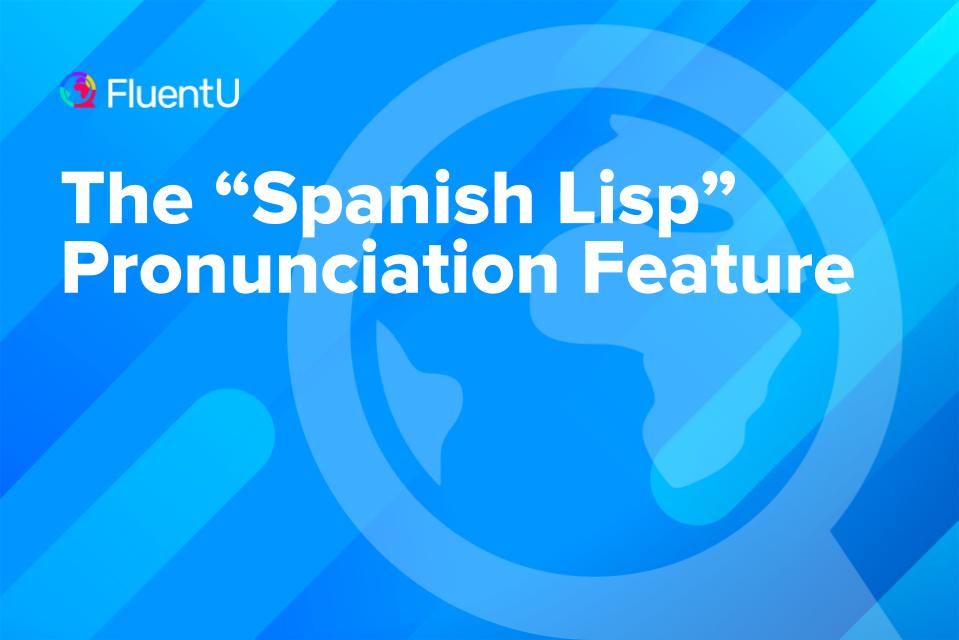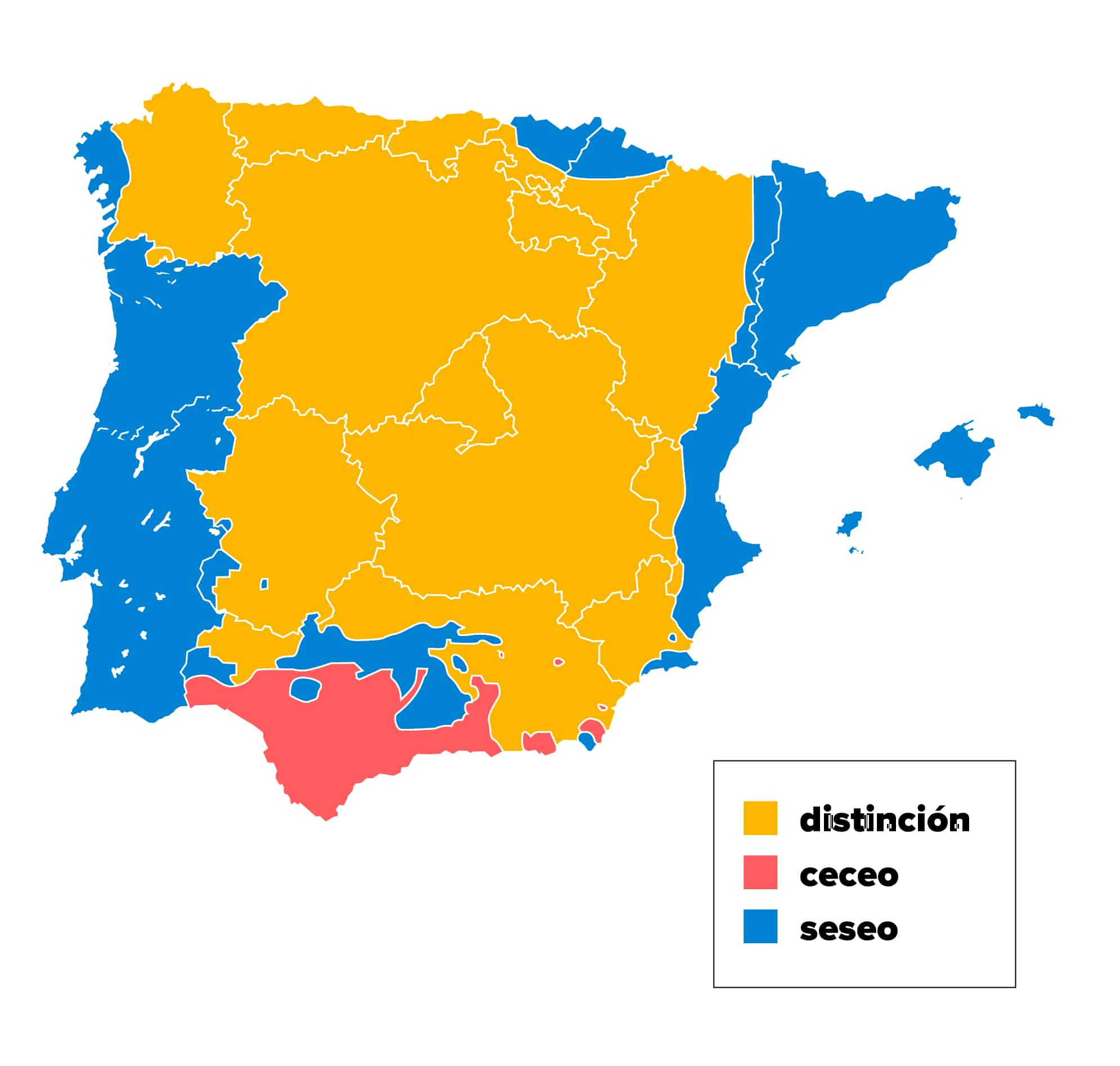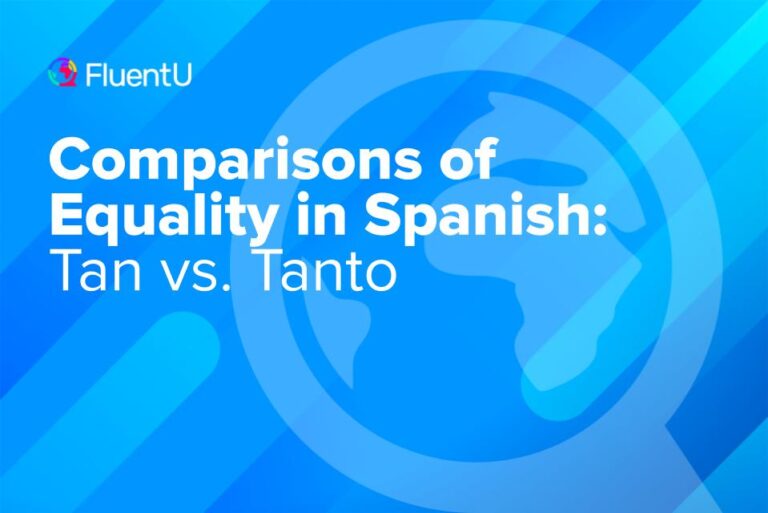Contents
The “Spanish Lisp” Pronunciation Feature

If you’re a U.S.-based Spanish speaker like I am, you might have some questions about why Spaniards pronounce the s sound differently from Latin American Spanish speakers.
The so-called Spanish “lisp,” which is actually more like a /th/ sound, or [θ] in IPA, is called the ceceo and it’s one of the most distinctive features of European Spanish.
Read on, mis amigos (my friends), to find out more about the ceceo (plus the seseo and distinción), and how you can master and practice it.
Get ready to really use your tongue!
Download: This blog post is available as a convenient and portable PDF that you can take anywhere. Click here to get a copy. (Download)
What is the Spanish “Lisp”?
The Spanish language has many different regional dialects with various differences in grammar, vocabulary and pronunciation. One unique pronunciation feature of European Spanish is the “th” sound, written as /θ/ in IPA, which English speakers like to call a lisp.
The Spanish lisping pronunciation can potentially affect the pronunciation of three different letters: s, z and c (when it’s followed by an e or an i).
Depending on where you are and who you’re talking to, these letters can take one of two sounds: They either sound like an English s or an English soft th, like you can hear at the end of the word “tooth.”
The terms distinción, ceceo and seseo describe how you should pronounce s, z and c. The two forms that constitute the use of the “lisp” are distinción and ceceo, whereas seseo requires no lisping at all.
Keep in mind that even though we’re using the term “lisp” for the sake of clarity in this post, the target sound is not, in fact, a lisp. It’s just a unique pronunciation element in certain parts of the Iberian Peninsula, as we mentioned above.
1. Distinción — The distinción (meaning “difference”) is the most popular trait of Spanish from Spain. In these places that use distinción, you pronounce an s like an English s, but a c or z like a th.
2. Ceceo — In areas with the ceceo, you pronounce s, z and c like the th in “tooth.” The verb for using this pronunciation is cecear.
3. Seseo — In areas with the seseo, you pronounce all three of these letters like an English s. The verb for pronouncing like this is sesear.
Keeping in mind that θ is pronounced like “th,” let’s compare the pronunciation of different words using distinción, ceceo and seseo. We have bolded words which are “lisped.”
| Gracias (Thanks) | Taza (Cup) | Tasa (Rate) | Ases (Aces) | Haces (Do) | |
|---|---|---|---|---|---|
| Distinción | ['graθias] | ['taθa] | ['tasa] | ['ases] | ['aθes] |
| Ceceo | ['graθiaθ] | ['taθa] | ['taθa] | ['aθeθ] | ['aθeθ] |
| Seseo | ['grasias] | ['tasa] | ['tasa] | ['ases] | ['ases] |
If you’re an intermediate or advanced Spanish learner you should find this video interesting—it gives a detailed look at the pronunciation of ceceo and seseo.
For everyone else, the video below gives a great overview of the differences we’ve just discussed, including lots of example words and some interesting tidbits about the Spanish lisp.
The Origin of the Spanish “Lisp”
There’s an often-repeated myth that King Ferdinand of Spain had a lisp, and that his countrymen imitated him as a form of respect, which led to the development of the Spanish lisp.
Historians and linguists have refuted this claim, arguing that there’s no evidence King Ferdinand had a lisp. Besides, if that were the case, the predominance of distinción (instead of ceceo) in Spain would still not make sense.
It’s more likely that ceceo and distinción had their roots in medieval Spanish speech patterns, which developed naturally over time to regional variations.
So, why don’t Latin Americans have this lisping form of pronunciation?
Well, history tells us that Seville was one of the most important cities in Early Modern Spain, and it was the peninsula’s most important trading hub with the new colonies in the Americas.
In fact, a large percentage of early settlers in the New World colonies came from Andalucía and the Canary Islands—both seseo areas. Thus, this linguistic form eventually took predominance in the New World.

Where Spanish Speakers “Lisp” Their S Sounds
You won’t find Spanish speakers lisping in any of the countries of Latin America or the Caribbean. This is also why most Spanish learners in North America don’t encounter the lisp in a Spanish classroom.
On the other hand, most of Spain embraces the Spanish lisping pronunciation in one form or another. See the map of Spain above to view the distinctions by region.
In Andalucía, pronunciation borders get a bit more complicated. TranSpanish has a handy map of the region showing where each variation can be heard.
How to Pronounce the Spanish “Lisp”
I could just tell you to pronounce your c and z (and s, if you want to cecear) like an English th. However, it’s a bit more complicated than that. English has two th sounds, and it’s important to use the right one.
Slate has an article that helps explain the difference between the two th sounds. To feel this difference, put your hand on your throat and say the words “then” and “thing.” You’ll notice that your throat vibrates when you say “then,” but not when you say “thing.”
The correct way to lisp is the second way—the one where your throat doesn’t vibrate. Some other English words that contain that th sound are “thought,” “tooth” and “three.”
The Spanish Dude has a helpful video with Spanish lisp pronunciation tips.
How to Practice Proper Spanish Pronunciation
Watch and Listen to Authentic Video Material
One of the best ways to practice is to watch Spanish television, immerse yourself in authentic clips and listen to authentic Spanish audio. If you hear enough native speakers lisping, it’ll eventually sound natural and will become easier to incorporate into your own speech.
One great resource for Spanish videos with native speakers using the Spanish lisp is the FluentU language learning program.
FluentU takes authentic videos—like music videos, movie trailers, news and inspiring talks—and turns them into personalized language learning lessons.
You can try FluentU for free for 2 weeks. Check out the website or download the iOS app or Android app.
P.S. Click here to take advantage of our current sale! (Expires at the end of this month.)

Sing Along
If you aren’t already singing in Spanish to improve your pronunciation, now’s the time to start. Find a Spanish singer (from Spain, that is) and sing along to one of their songs, paying particular attention to their pronunciation of c and z.
One good place to start is the song “Deshazte de mi” (Get Rid of Me) by the Madrid-born singer Malú. In the first verse alone, you can practice the words necesitas (you need), vacía (empty), principio (beginning), hice (I made), cerraba (closed) and hacía (I made), all of which include a lisp.
Some other good Spanish songs with ample lisping include “Cero” (Zero) by Dani Martin and “Quisiera” (I Wanted) by Frank Diago.
Make Flashcards
Another good way to practice the lisp is to make a list of words that showcase c, z and s sounds and turn them into flashcards.
For example, you could use word pairs like ciento (one hundred) and siento (I sit) and cazar (to hunt) and casar (to marry), or pair single words that have both sounds such as cesar (to cease) or superficie (surface).
Why Learn the Spanish “Lisp”?
I didn’t bother lisping in my first few months in Spain. Then, one day, I was having a conversation with a friend and she told me about her family from the small village of Siruela.
“Siruela?” I asked. “You mean, like the fruit?”
She looked at me in confusion for a few seconds, then burst out laughing. “No, that’s ciruela,” she said, pronouncing the word for “plum” with a discernible “lisp” on the letter c.
That’s when I realized: Learning this distinct form of pronunciation from Spain could help me avoid lots of confusion when talking to Spanish-speakers.
There are many word pairs that become more easily distinguishable when you use the Spanish “lisp.” For example, the words casar (to marry) and cazar (to hunt) have practically the same pronunciation unless you’re using the lisp.
Learning this form of pronunciation will also help broaden your comprehension when listening to Spanish speakers talk, or when consuming Spanish media.
Plus, learning regional variations of Spanish is fun! If you’re living in Spain, speaking the way those around you speak is part of the immersion process.
Hopefully, after reading this post, you won’t be quite so baffled by the Spanish lisp any longer. With a little practice, you’ll be replacing your c and z sound with a th sound like a local—but only in the right regions!
Download: This blog post is available as a convenient and portable PDF that you can take anywhere. Click here to get a copy. (Download)
And One More Thing…
If you want to learn Spanish with authentic materials but need a little extra support, then you need to know about FluentU.
FluentU lets you consume the same content as native Spanish speakers, but with tools to make it easier to pick up the language while you watch. You’ll learn Spanish as it’s actually spoken by real people, unlike programs that use scripted content.
You can bring our learning tools directly to YouTube or Netflix with the FluentU Chrome Extension, or check out our curated video library full of clips that cover a wide range of topics, as you can see here:
FluentU brings native videos within reach with interactive subtitles. You can tap on any word to instantly see its meaning, an image, and its audio pronunciation. Click on the word for additional examples and to add it to your flaschards.
To reinforce what you've learned, you'll complete engaging exercises and see more examples of the key words from the video. FluentU keeps track of the vocab you’re learning, and gives you extra practice with difficult words.
Start using the FluentU website on your computer or tablet or, better yet, download the FluentU app from the iTunes or Google Play store. Click here to take advantage of our current sale! (Expires at the end of this month.)











